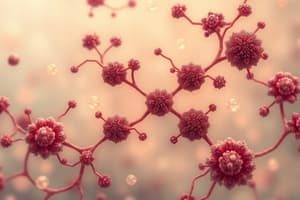Podcast
Questions and Answers
What is the primary mechanism of endocytosis for drug delivery?
What is the primary mechanism of endocytosis for drug delivery?
Endocytosis involves the engulfment of a drug molecule by the cell membrane, transporting it into the cell by pinching off the drug-filled vesicle.
How does pH affect the absorption of weak acids and bases?
How does pH affect the absorption of weak acids and bases?
The pH affects the equilibrium between the charged and uncharged forms of the drug, thus influencing which form can permeate the membrane.
Explain saturation kinetics in relation to drug transport.
Explain saturation kinetics in relation to drug transport.
Saturation kinetics refers to the process where the rate of drug transport by a carrier reaches a maximum as all binding sites become occupied.
What role does the Henderson-Hasselbalch equation play in drug absorption?
What role does the Henderson-Hasselbalch equation play in drug absorption?
Why do uncharged drug forms pass through membranes more readily than charged forms?
Why do uncharged drug forms pass through membranes more readily than charged forms?
What are the four main stages of pharmacokinetics?
What are the four main stages of pharmacokinetics?
How does passive diffusion function in drug absorption?
How does passive diffusion function in drug absorption?
Describe facilitated diffusion and its energy requirements.
Describe facilitated diffusion and its energy requirements.
What role does the liver play in drug metabolism?
What role does the liver play in drug metabolism?
What drives the process of active transport in drug absorption?
What drives the process of active transport in drug absorption?
Explain the elimination phase of pharmacokinetics.
Explain the elimination phase of pharmacokinetics.
What is the significance of lipid solubility in drug absorption?
What is the significance of lipid solubility in drug absorption?
What characterizes the process of drug distribution in the body?
What characterizes the process of drug distribution in the body?
Flashcards
Active Transport
Active Transport
A process where molecules move from an area of low concentration to an area of high concentration, requiring energy. This often involves carrier proteins, which have a limited number of binding sites, resulting in 'saturation kinetics'.
Endocytosis
Endocytosis
A process involving the engulfment of large molecules by the cell membrane, forming a vesicle that transports them into the cell.
pH & Drug Absorption
pH & Drug Absorption
The ability of a drug to pass through cell membranes is influenced by its ionization state, which is dependent on the drug's pKa and the pH of the environment.
Weak Acid & Base Absorption
Weak Acid & Base Absorption
Signup and view all the flashcards
Henderson-Hasselbalch Equation
Henderson-Hasselbalch Equation
Signup and view all the flashcards
Drug Absorption
Drug Absorption
Signup and view all the flashcards
Passive Diffusion
Passive Diffusion
Signup and view all the flashcards
Facilitated Diffusion
Facilitated Diffusion
Signup and view all the flashcards
Drug Distribution
Drug Distribution
Signup and view all the flashcards
Drug Metabolism
Drug Metabolism
Signup and view all the flashcards
Drug Elimination
Drug Elimination
Signup and view all the flashcards
Pharmacodynamics
Pharmacodynamics
Signup and view all the flashcards
Study Notes
Pharmacology
- Pharmacology is the science of drugs.
Pharmacokinetics of Drugs
- Pharmacokinetics describes how the body absorbs, distributes, metabolizes, and excretes drugs.
- Absorption: Drug absorption from the administration site into the bloodstream.
- Distribution: The drug moves from the bloodstream into interstitial and intracellular fluids.
- Metabolism: The drug is chemically altered by the liver, kidneys, or other tissues.
- Elimination: The drug and its metabolites are removed from the body in urine, bile, or feces.
- This process follows a sequence with drug absorption, distribution, metabolism, and elimination. The diagram shows absorption, distribution, metabolism, and elimination as sequential steps; the diagram also shows these concepts as inputs and outputs.
Absorption of Drugs
- Absorption is the movement of drugs from the administration site to the bloodstream.
- Mechanisms of drug transport include:
- Passive diffusion: The driving force is the concentration gradient, moving from higher concentration to lower concentration. Lipid-soluble drugs readily cross biological membranes because of their solubility in the lipid bilayer membrane.
- Facilitated diffusion: specialized transmembrane carrier proteins facilitate the passage of large molecules, changing their conformation to move drugs into or out of cells. This does not require energy and can be saturated.
- Active transport: Carrier proteins are driven by energy (often from ATP hydrolysis). Drugs can move against a concentration gradient. This process shows saturation kinetics for the carrier.
- Endocytosis: The cell membrane engulfs and transports drugs into the cell. Drugs with exceptionally large size can use this method.
Effect of pH on drug absorption
- Most drugs are weak acids or weak bases.
- The charged form of an acid or base goes through a membrane less readily compared to the uncharged form. For weak acids, the uncharged form passes through membranes readily, whereas the charged form doesn't. Conversely, for weak bases, the uncharged permeable from passes more readily through membranes compared to the charged form.
- The effective concentration of the permeable form is determined by the ratio between the charged and uncharged forms. This ratio is dependent on pH and pKa (Henderson-Hasselbalch equation.)
Studying That Suits You
Use AI to generate personalized quizzes and flashcards to suit your learning preferences.




